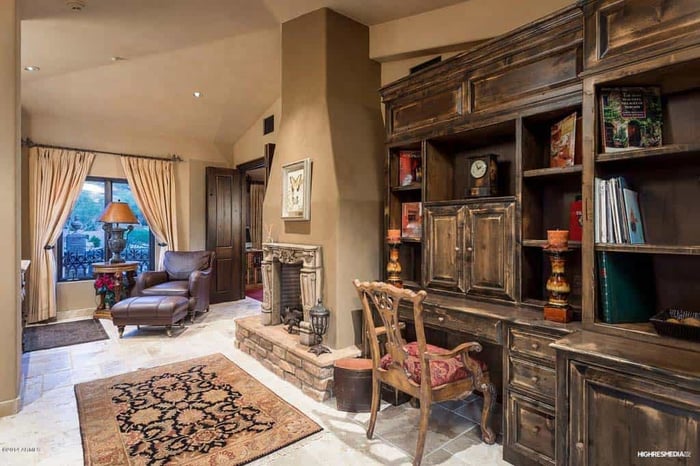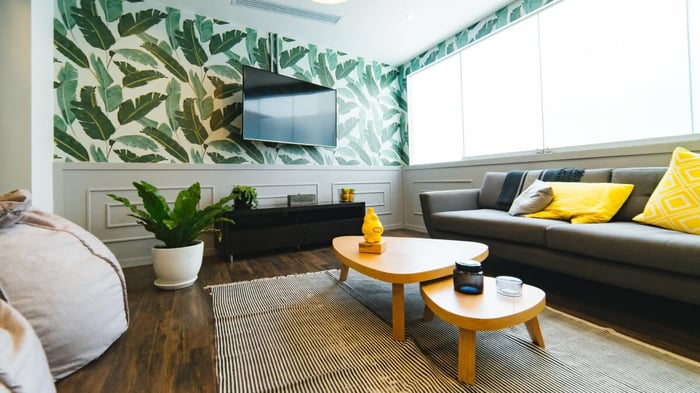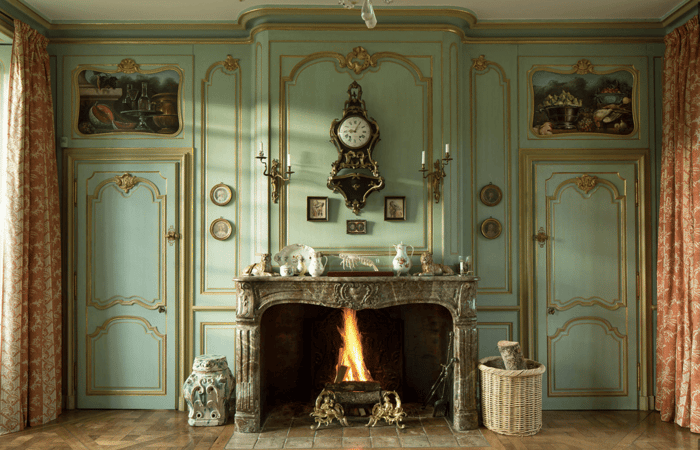Gothic is Rustic. Rustic shares more than fifty percent of the same applications as Gothic design. The main difference between the two lies with the heavier, darker, and more detailed elements of the Gothic style. Rustic has taken the natural elements from Gothic and simplified it. When merged together, the Gothic-Rustic look creates a modern home design that exudes a harmony of classic metal works and raw nature in all aspects.
GOTHIC HISTORY
The style known as Gothic was born during the medieval period, between the 12th to 16th centuries. This style is an offshoot of Romanesque buildings. The architectural features are some of the first things that spring to mind when thinking about Gothic style, such as pointed arches, heavy fireplaces, stained glass, and large arched wooden ceiling beams. Floors made of stone, uncut tiles, or dark stained hardwood elicit feelings of a castle-like retreat. As you can see, most of these elements come straight from nature, thus the connection to the modern Rustic style.
Drama is the main theme of striking Gothic interior spaces. Dark and rich colors such as deep purples, reds, and greens with of course the traditional black staple are the palette for a Gothic room.
RUSTIC HISTORY
Coming from the natural inspirations of the fifty year period of the Romantic movement from roughly 1790 until 1840, this style was influenced by the celebration of the individual and awe of nature. Rustic design moved towards simplicity and the rugged beauty of nature. Furniture and fabrics came straight from the outdoors: weathered wood, stone, concrete, hemp, wool, and cotton. Neutral wall colors, in simple and earthy colors, looked for organic warmth. Large windows shed the heavy draperies of the Gothic period and instead filled the space with natural light. While rustic style in its most traditional sense began as heavy and dark, a contemporary rustic style has emerged that feels both fresher and lighter, while remaining grounded in the earth.
MERGING THE TWO
Raw Elements
To create a genuine nature-infused home that exemplifies the Gothic-Rustic style, the most important component is going to be the use of raw natural materials. From floor to ceiling and everything in between, presenting a cohesive contemporary display of this style throughout the entire space will stand on the shoulders of nature.
Floors
If you’re starting off with a stone or concrete floor all the better as this is a foundation for the Gothic part of this look. The next option is to install a hardwood floor, or the faux vinyl style wood-look flooring designs, and then add an animal skin style throw rug. Wide plank wood floors are another absolutely stunning option to use. Because of their simple and solid appearance, wide wood planks on the floors provide an automatic substructure for decorating in a Gothic-Rustic style.
 Ceilings
Ceilings
Wood beams are of course an excellent way to display the feeling of nature in your home. These can be left raw and unpainted or if needing to balance out other heavy elements in the room- a large fireplace or dark furnishings for example- white washed or painted ceiling beams will look just as splendid. Ideally you want to be able to see and feel the knottiness of the wood, its grain, and natural tones. As other wood elements will no doubt be used in additional areas of the home, seeing the differences in the textures of the variety of woods keeps them separate and interesting.
Fireplace
No Gothic-Rustic home would be complete without a warm, inviting fireplace. To continue the natural theme, the fireplace can be constructed out of visually weighty natural elements: bricks, rocks, stones. Topped by a hearty mantel piece, this will tie your living or family room together.

Furniture
When working to integrate Gothic and rustic furniture styles there are a few points to consider. Most Gothic furniture tends to be ornately carved and heavily stylized in its design. When combining with the rustic traditions, you don't want to have a large armour with pointed tops and highly decorated mouldings; or deep purple velvet couches. You’re looking for the more natural wood, solid and chunky pieces from that period. These tend to be smaller, more accent type selections. Such as end tables, side tables, ottomans, and simple solid chairs. This handcrafted end table (below) is the perfect example of merging the two strong styles. If choosing a Gothic focus object, balance the room out with nature inspired accent decor. Visualize simple, peasant-artisan style; employing use of branches, driftwood, and other materials straight from nature. Large, stable pieces like the famous Adirondack chair are clearly identified with the rustic style.

Lighting
Glass, metal, wood, wrought iron are both popular in Gothic and rustic lighting options. Many designs these days combine the chandelier styles of Gothic times using raw materials of a rustic nature. Setting the mood with various wall fixtures, hanging lights, and lamps aids in creating the perfect atmosphere for a rustic home that has modernized its Gothic counterparts.
 Fabrics
Fabrics
Natural, solid fabrics are the best fabrics for the foundation of Gothic-Rustic style; linen, wool, woven textiles, burlap, and canvas are automatic choices. Woven blankets in bold, simple patterns. No flowers, frills, or fringes included. Handcrafted, displaying the perfectly imperfect nature of homemade textiles works divinely.
Accents
Woven baskets, large and small, are ideal items to use for display as well as organizing in this design scheme. Found objects with a worn aesthetic are other prime accessories in a rustic styled home. A vase full of branches, small rusted metal barrels, or a bronzed twig-shaped art accent that merges the old with the new, nature and handcrafted are all examples of the ultimate accents. Handmade wall hangings or signs framed with metal elements are a simple way to add character to a space, and again another excellent marriage of the two styles. The goal is to create a down-to-earth feeling, selecting nature-inspired details that also provide distinct presence and drama.
Color
Gothic colors are dominated by dark and heavy. To combine this style with rustic, we can keep the richness of nature or earthy toned colors, but limit them to accent walls or single pieces. Choosing an emerald green, dark blue, or rich golden hues are some of the compromised colors to work with. The rest of the space is balanced out by the more neutral colors of a traditional rustic toned home.
SUMMARY
Merging natural elements from both the Gothic and rustic styles ultimately creates a space that is focused on earth, nature, and feeling grounded. A hint of a romantic atmosphere flows in with the addition of stained glass art, vases of fresh or dried flowers, large mirrors, and the warmth of fireplaces and candles nestled throughout.
All elements needed to craft your Gothic-Rustic home have already been created. From either centuries ago, or by artisans across the country during simpler times. Mining thrift and consignment stores, estate and yard sales, as well as your local flea markets is a way to, one, save money on your purchases; two support local business; and three keep it ‘green’ and environmentally responsible by choosing not to buy products made from use of raw materials or plastics. Enjoy the hunt and happy decorating.
#gothichome #gothic #gothicdecor #gothichomedecor #gothdecor #gothhome #gothaesthetic #gothhomedecor #skulls #gothgoth #gothicstyle #gothicart #oddities #darkdecor #handmade #rustic #rusticdecor #homedecor #vintage #handmade #farmhouse #interiordesign #decor #wood #woodworking #diy #farmhousedecor #home #design #furniture #decoration #shoplocal #farmhousestyle #art #antiques #interior








